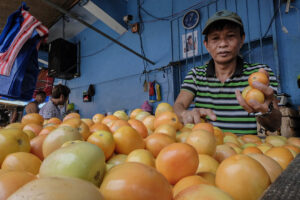By Luisa Maria Jacinta C. Jocson, Reporter
MORE THAN P300 billion could be released into the Philippine economy after the central bank slashed the reserve requirement ratio (RRR), analysts said.
“We estimate the impact of the 250-basis-point (bp) RRR cut to be a liquidity injection of around P310-330 billion (around 1.2% of full-year 2024 gross domestic product), which is relatively substantial,” Nomura Global Markets Research said in a commentary.
The Bangko Sentral ng Pilipinas (BSP) on Friday said it would reduce the RRR for big banks and nonbank financial institutions with quasi-banking functions by 250 bps to 7% from 9.5%, effective Oct. 25.
It will also reduce the ratio for digital banks by 200 bps to 4%; thrift banks by 100 bps to 1%; and rural banks and cooperative banks by 100 bps to 0%.
Rizal Commercial Banking Corp. Chief Economist Michael L. Ricafort said that for every one-percentage-point (ppt) reduction in the RRR, at least P150 billion would be injected into the financial system.
The 250-bp or 2.5-ppt cut for big banks and nonbanks could lead to at least P375 billion released by large banks, he said. Accounting for all banks, a total of P400 billion could be injected into the financial system.
The RRR is the portion of reserves that banks must hold onto rather than lending out. When a bank is required to hold a lower reserve ratio, it has more funds to lend to borrowers.
Nomura said it expects the BSP to further cut the RRR next year.
“In our view, BSP’s goal is to reach 5% in 2025, so we would expect more RRR reductions next year, owing to our expectation that headline inflation remains within BSP’s target.”
BSP Governor Eli M. Remolona, Jr. earlier said they are eyeing to bring down the RRR to as low as 5% as the country’s reserve requirements are among the highest in the region.
“We also did not see any urgency for the adjustment based on limited signs of liquidity tightening,” Nomura said. “We believe the move is just BSP getting back to its longer-term commitment to reduce the RRR to low single-digit levels which was previously targeted by 2023 but was delayed due to rising inflation risks.”
The central bank has since brought down the RRR for universal and commercial banks to a single-digit level from a high of 20% in 2018.
In its statement, the BSP said the RRR cut is in line with efforts to “reduce distortions in the financial system.”
“The reductions will lower intermediation costs and promote better pricing for financial services,” it added.
Mr. Ricafort said the lower reserve requirement would spur demand for loans.
“Furthermore, there would be more pesos that could be invested in the financial markets such as bonds and other fixed-income investments, stocks, foreign currencies, property, among others that would help support price gains than otherwise,” he added.
RISKSMeanwhile, Enrico P. Villanueva, a senior lecturer at the University of the Philippines Los Baños Economics Department, said the RRR cut has “serious repercussions on financial stability.”
“While the reduction of reserve requirements lowers intermediation costs, reserves remain a monetary tool for liquidity risk management and financial stability.”
Mr. Villanueva said that while there may be space to further slash the reserve requirements of big banks, this might not be the case for smaller banks.
“The very low RR for thrift, rural and cooperative banks is disconcerting given that most of the bank failure incidents in the Philippines are in this sector. Those RR levels might need a reassessment from a financial stability perspective,” he said.
With the BSP’s recent RRR reduction, rural and cooperative banks essentially do not need to keep any reserve requirements as their ratios were slashed to 0%.
“In the Philippine financial system where episodes of bank failures emanate mostly from thrift and rural banks, what will help stabilize that fragile sector if their reserve ratio ranges from 0-1%?” he added.
Mr. Villanueva also noted that the RRR cut would not immediately translate to savings for consumers.
“A cut in the required reserve ratio will certainly lower banks’ cost of funds. However, there is no automatic and full transfer of rate cost savings to borrowers,” he said.
“The degree of past-through of savings to borrowers will depend on the level of bank competition, elasticity of demand for loans, and business clout of borrowers. Institutional clients will likely benefit most; high-risk retail clients probably the least.”
The RRR cut will have a “muted” impact on bank lending in the short term, Mr. Villanueva said, adding that loan demand and credit standards would “significantly improve” in the long term amid more certainty on the country’s economic outlook.
“The sooner the calibrated rate cuts are completed, the more certainty and confidence to do investment and loan planning,” he added.
“If reserve ratio reductions eventually lead to loanable funds far exceeding loan demand by creditworthy borrowers, banks may be enticed to relax credit standards and give in to too much subprime lending… Banks may be encouraged to invest in higher risk assets like lesser-rated corporate funds,” Mr. Villanueva said.
He said the BSP should be vigilant in “mopping up excess liquidity and preventing excessive risk-taking and asset bubbles.”
Meanwhile, Filomeno S. Sta. Ana III, coordinator of Action for Economic Reforms, said that the RRR cut does not necessarily lead to increased investments despite expectations of higher loan demand.
“The caveat is that this positive development by itself will not guarantee that businessmen will start pouring investments into the Philippine economy,” he said via Facebook Messenger.
“The administration must address the prevailing policy uncertainty arising from other bad policies that for example have constricted fiscal space, intensified political conflict and abetted geopolitical tension,” he added.
Leonardo A. Lanzona, Jr., an economics professor at the Ateneo de Manila University, said this could attract short-term rather than long-term investments.”
“In other words, this can only push aggregate demand but leave aggregate supply constant, thus resulting in inflation,” he said in an e-mail.
For his part, Mr. Villanueva said the RRR cut’s impact on inflation would likely be minimal.
“While reduction in required reserves will initially release more funds into the money in circulation, they may eventually end up as more loans, higher bank placements with BSP, or more bond holdings. BSP may do mopping up operations if there is excessive money supply.”
“The RRR cut may be inflationary in the unlikely (but possible) event that banks channel the extra funds into conspicuous consumption loans or speculative real estate lending.”
Nomura said that the RRR reduction reflects the central bank’s “greater confidence” on easing inflation.
“With inflation remaining on a downward path, BSP has scope to further remove the restrictiveness of its monetary stance,” it said.
Nomura expects the BSP to cut by another 25 bps each at the Monetary Board’s remaining meetings this year on Oct. 17 and Dec. 19. It also forecasts 75 bps worth of cuts early next year, bringing the key rate to 5% by May 2025.
“The Fed’s cutting cycle should also support more BSP rate cuts ahead, in our view, but we see these RRR cuts as supportive of our view that BSP sticks to a measured approach, i.e. 25-bp clips, despite the Fed delivering an outsized 50 bps this week, in part because some of the easing is already done via the RRR reduction,” it added.















